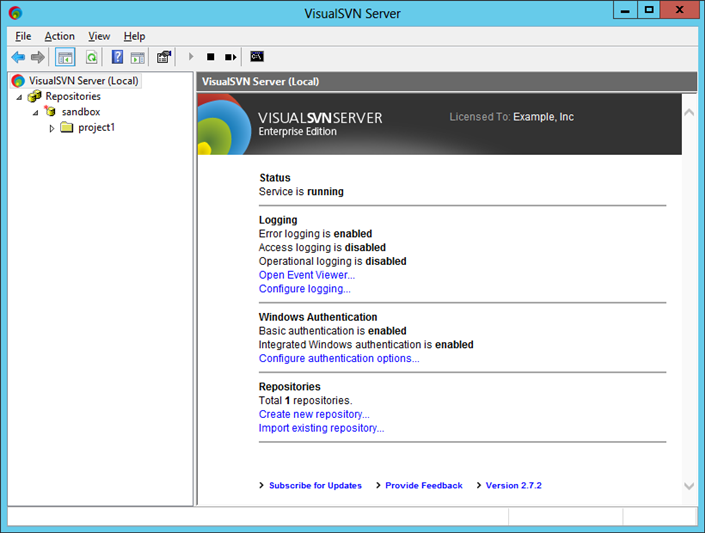
- Visualsvn https not working install#
- Visualsvn https not working update#
- Visualsvn https not working software#
- Visualsvn https not working code#
- Visualsvn https not working download#
If you want to use a space, or a comma, you must add also the separator inside. Then at the end if we want at least one: (#?(\d+))+īut here we don't take into account yet the separator between the different mantis ID. and specify how many occurences: "+" at least one ? or "*" zero or at least one. encapsulate the expression in a new pair of parenthesis, for instance: (#?(\d+)) If you want this occurence to be repeated you need to: That's the meaning of the "?" when placed after the letter. Bummer, but be wrote:/(?:bugs?|issues?|reports?)+:?\s+(?:#(?:\d+)*)+/iĬurrently i am using Following regex, which is working for single bug id.īug Link Regex Pass 1:- /\b(?:bug|issue|task)\s*" is better written as: "#?". When you connect to your new Visual SVN Server instance over another port, your browser will likely complain that the certificate isn't trusted and it'll turn your Address Bar red and scary.
Visualsvn https not working download#
Incidentally you can also view and download files from your shares, so choose strong passwords. I can RDP (Remote Desktop Protocol) into those machines if I like, and I can also remote into my Home Server itself. Notice you can see what machines are online at home in the background there. Here's me logging into my Home Server from elsewhere. Note, you can also log into your Home Server remotely, if you've enabled it. This domain name is associated with your Windows Live ID and the IP is automatically updated by the Home Server. Windows Home Server also includes options to get your own Home Server-provided domain under the "Settings" dialog in the Home Server Console. There are applets that will run in the tray on your Windows Home Server and keep that IP address in sync if it changes. You might consider using a service like DynDNS and get a custom domain like.

You can also hard-code it in your hosts file on the machine that will be your client. You can certainly just visit and remember your address if you like. Check your router or visit (usually) to figure it out. I then logged into my local router and set up a port-forwarding rule to make sure that 8443 was accessible from the outside. However, that itself seemed wonky? My way seems to work. This way I get backup and duplication in a nightly snapshot.Īlternatively, I probably could have mapped a permanent local Z:\ drive on the Home Server to \\server\svn or some share, and told VisualSVN Server to use that. I then used the "Add Schedule Task" wizard and made this run every night at 2am. This "mirrors" the D:\repos folder to the \\server\svnbackup. Robocopy /mir d:\repos \\server\svnbackup Then, I installed the Windows 2003 Resource Kit in order to get the RoboCopy tool, and I copied RoboCopy to C:\windows so it's in the path.įinally, I made a batch file that looked like this: Then I made a new Share called \\SERVER\SVNBackup and set duplicate to true. I made a folder on the D: drive (against recommendations) called D:\repos and I told Subversion that was the place to put stuff.
Visualsvn https not working update#
If you have a better idea or you work for the Home Server team, let me know if this is dangerous and I'll update this part of the post.

Here's the only/most wonky part of this whole thing. Always access data through shares like \\server\svnwhatever. You are NEVER supposed to put anything on the D: (Data) drive directly.

Windows Home Server is a different beast as it supports a RAID-like storage system. You can test if you have open ports with this online tool. It's easy to remember and less likely that your ISP would block it outgoing from your house. I could put it anywhere, of course, but 8080 is to 80 as 8443 is to 443. It's kind of like the secondary SSL port. I installed it on the machine on port 8443. I downloaded and installed VisualSVN Server, which is the absolute easiest way that I know of to get Subversion (SVN) on Windows.
Visualsvn https not working software#
I usually download software to the desktop, ignore the "holy crap don't do this" warning (although be aware) then open an administrator command prompt and run the MSI from there. From inside my house, I run "mstsc /console" or "mstsc /admin" from the Start | Run dialog, the connect to my machine called "Server." 2.
Visualsvn https not working install#
If you want to install software on your Home Server (and they are headless usually - no monitor) you have to use Remote Desktop. Since I already have this lovely Windows Home Server that's saved my marriage, I figured why not host it there? 1. I don't want to use the machine I host my blog on, as I want the data in my house. I decided I'd try to host a Subversion Server.
Visualsvn https not working code#
I put most of my docs in Live Mesh, and I host must of my Open Source projects at CodePlex, but I have a bunch of code and presentations that usually just float around. If your ISP calls your house and is mean to you, or if you lose all your personal data because of my tips, know that we never spoke. Disclaimer - People have been injured and emotionally scarred listening to my technical tips.


 0 kommentar(er)
0 kommentar(er)
